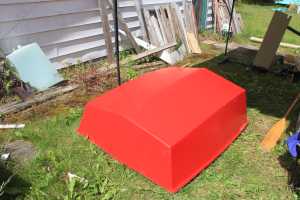
Yup, Thats a small boat all right...
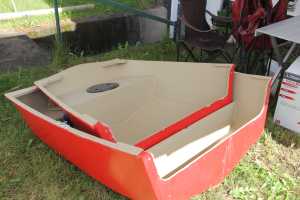
Turn it over.... look an even smaller boat inside!
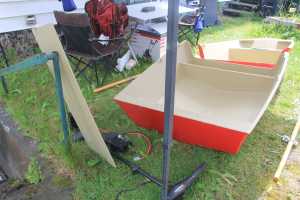
So lay the two small boats out on the lawn...
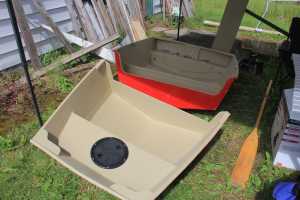
or beach or in the water, Like so
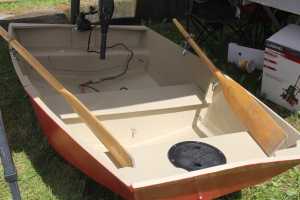
Screw the halves together..
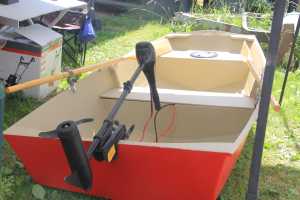
Add oars and a motor...
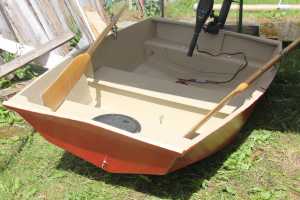
It should be fine to assemble this in the water as both halves float. The other possibility would be to assemble it on deck and lower it. (see update below)
The dinghy is strong and easy to walk across to get to the anchor winch. The front end is a nice place to sit but there is still room to sit on the cabin top... Mark's favourite place while motoring.
Putting the halves in the water turned out to be straight forward too. Tie a line or clip a line to each half and toss them into the water one at a time. The lines are then walked to our favoured mooring spot at the stern of Norah's Arc. There really is not enough room on deck to assemble it there. (or at least I have not figured out a way to do so)
Because the aft part is larger and floats more weight, the dinghy assembler boards that half. One has to try to stay as close to the centre as possible while assembling the dinghy or the ends and corners become easy places for water ingress. So a long reach is required at least until the first few bolts are started. Then one can move to the centre of the dinghy to finish fastening together.
The battery (there is room under the centre seat for two), oars and motor are light enough that they can be handed down by any of our crew members from the ship to dinghy. This dinghy is a bit tender initially and we like to be careful how we move around and where we sit. We found that as pictured, The two of us (Laura and I) were able to pick up the whole assembly, though it is still a bit heavy. If we had a large stretch of beach to cross at low tide, it might make sense to remove the battery and motor first.
I know that a trolling motor does not exactly look "go fast" but this dinghy is made to row or sail and not plane. It's maximum speed as a displacement boat will be 3.7 knots and the maximum recommended motor is 2HP. This motor is a little less than 1HP but still moves the dinghy with impressive authority. Certainly better than it was able to push the barge like inflatable boat around. There is a better propeller available for this motor that will make it more suitable for the roll of a primary mover. (and leave us with a spare propeller too)
Last year we used an AGM 100 AH battery (that weighs 90 pounds). An AGM battery should only be discharged to 50%. We had no way of measuring how much juice it took to go places and only used it to go to the nearest shore and back. The new battery is a Lifepo4 battery that is also 100 AH but can be discharged almost to 0% without harm and even then should last much longer than the AGM (which is now a part of our house bank). The new battery weighs less than 30 pounds and has a connection to my cell phone. We found that the same trip to shore took 12% of the charge and that current draw at full speed was 38 Amps out of the rated 45 Amps. A propeller with a steeper pitch could be used for a bit more speed. So we feel comfortable taking longer trips.
In one of those trips we went to the next island which has a nice beach to play on. While there I took the dinghy out for a row. My experience with rowing has been limited to planing boats which are more akin to barges than row boats. So my experience with this dinghy was fantastic. It rows very easy, and seems to get very close to the same speed as with the motor. I did not have time to install a skeg and so when I stopped rowing, it tended to turn it a circle.... next winter. This was not a problem though.
Disassembly was similar to assembly and I was used to the feel of things by then. I found I could lift the fore part of the dinghy up on deck just with the line but we used the main halyard to lift the heavier aft end. I would like to add a spinnaker halyard to the boat, so maybe a forward boom that is shorter than the gin pole we have would make a proper davit for this purpose. The gin pole we have could be made to work I guess but it would be awkward.
Things I would like to change: Add the skeg... maybe with a wheel for beaching. Something better on the bottom (a rubber strip?) to protect it. We lost a lot of paint. Outfit it for sailing as per the plans. Add a second battery to bring it's range close to a gas powered motor. Use a better propeller for our use. The two bladed prop is nice for storage but a three blade prop would be more efficient.